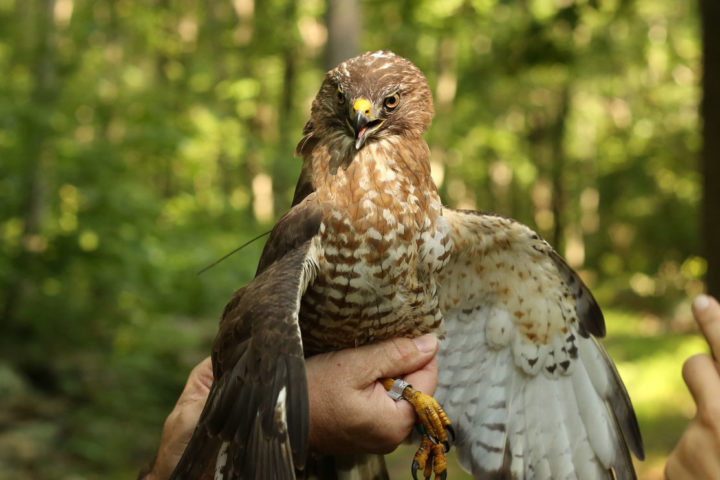By Marina Richie
Wild Skyway
“The Trail is an essential migratory route and a safe refuge for numerous species of North America’s birds”
The fluting notes of a wood thrush serenade your one-pot dinner. A barred owl hoots “who cooks for you” in the night. A loon’s wail coils around your heart on a Maine lake. Wherever you are on the Appalachian Trail, birds offer sweet companionship. Yet, as hiker numbers soar, bird populations tumble.
More than half of North America species are experiencing major declines. We have a few billion less birds than 40 years ago. In one drastic example, the golden-winged warbler nests in multiple places along the A.T., including the Roan Highlands, where its numbers have plummeted by a staggering 98 percent. Within this sobering news, the A.T. shines with the promise of protection and ecological restoration. For instance, the Appalachian Trail Conservancy’s (ATC) habitat work on behalf of the golden-winged warbler is leading to an uptick in nesting birds, while serving hikers with more expansive views.
The ATC also partners with other groups to conserve the golden warbler’s critical winter home in Columbia and Venezuela. This work across international boundaries will help to ensure the survival of this species.
Peter Marra is the director of the Smithsonian Migratory Bird Center, devoted to the study, conservation, and championing of one of the great wonders of our planet — the migration of birds. He’s also an A.T. hiker who has trekked segments in all 14 states. “The Appalachian Trail and associated habitats provide a wonderful natural thoroughfare north to south that’s like an I-95 for birds,” he says.
For millions of our beleaguered birds, the Trail corridor from Georgia to Maine forms their skyway, shelter, and home. The heart-pounding rise and fall of Trail elevations results in a sweep of habitats and birds adapted to them. Those homes include intact forests that are essential for the future of nesting birds in trouble, including the wood thrush, cerulean warbler, and eastern whip-poor-will.

Author Marina Richie, as a child, watched raptors at Hawk Mountain Sanctuary in Kittatinny, Pennsylvania with her father Dave Richie — a former National Park Service official who played an important role in protecting the Trail. Later, Marina backpacked the Monson to the Katahdin section of the Trail with him in Maine.
“Every bird of the A.T. is magnificent — from the cerulean warbler winging from the Appalachians to the Andes,to the pileated woodpecker drumming on a tree. My father noted birds and wildflowers in his A.T. hiking journals in the 1980s and ‘90s, and yes, he listened to wood thrushes serenading his one-pot dinners. Here’s one entry of many that inspired my writing of this article: ‘Was awakened by a whip-poor-will right in front of the shelter at 5:30 am while it was still dark. Could just barely see his red eyes gleaming luminous when he flew.’ (6/1/86—about 10 miles south of Damascus, Virginia)
“Writing this piece connected me even more deeply to him, and to the grassroots legacy of the A.T. that gives me hope for the future of our imperiled birds.”
Discover More

Roan Highlands Haven
Appalachian Balds are for the Birds
The iconic bald mountains along the Appalachian Trail in North Carolina and Tennessee are significant to the future of migratory and resident birds.

A Premier Migration Range
What Soars Above Kittatinny Ridge
The 125 miles of the Appalachian Trail that follow Pennsylvania's Kittatinny Ridge see an incredible amount of hawk and eagle migrations.

A Song at Dawn
The Search for Bicknell’s Thrush
Nick Lund of Maine Audubon shares his face-to-face encounter with one of the rarest (and most elusive!) birds in the country.



